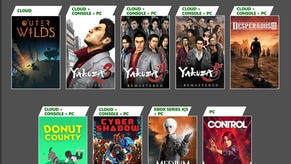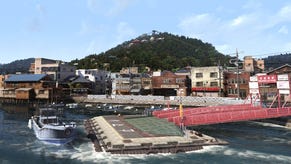Yakuza 4
SEGA's superseries broadens further.
Imagine a game that depicted a living, breathing London - not 1940s London, not post-apocalyptic London, but today's London, with every homeless drunk, ambling pedestrian and dingy side-street intact, every brand name, every overflowing bin. Imagine there was one Pret a Manger outlet for every six residents of the city, and you could walk in and choose from a selection of actual products they sell in real life - if practically every shop and brand in the whole game were a real one, fully endorsed and realistically reconstructed. This is what Yakuza is to Japan, and Tokyo in particular. Kamurocho might be a fictional, sleazy corner of the city, but it might as well be real; everything in it is true to life, even the adverts on the vending machines.
Of course, you run around this eerily accurate facsimile of the real world beating up gangsters who randomly throw down in the streets, often using nearby lampposts and/or motorcycles. This is a video game, after all. Yakuza's realism is all in the detail. It's the world's biggest-budget, most ambitious attempt at grounding a game's fiction in our own, tangible reality; outside of Shenmue there is nothing else that comes close to realising a world so immediately recognisable. Few people would call the Yakuza games realistic - the enjoyably overwrought plot and excessive violence see to that - but their authenticity is beyond compare.
SEGA's unveiling of Ryu ga Gotoku 4 at the Tokyo Game Show last month really focused on that authenticity. The presentation was equal parts footage of the game and behind-the-scenes chats with the various digital actors and voice talent lending credence to the game's characters. There are virtual likenesses of Japanese drama stars Kitaoji Kinya and Maju Ozawa, the female lead, and many other famous names providing voice work. Yakuza 3's half-million sales clearly made an impression on Japan - Yakuza 4 is going to be absolutely huge.

It's clearly built on the same engine as Yakuza 3 in that it looks exactly the same. The motion-captured digital acting is still very impressive, the environments still look eerily real, there are evidently no significant changes to exploration and combat save some wince-worthily violent new finishing moves. But there is one massive, series-defining change - our stern-faced yakuza hero Kiryuu is rolling with a crew now. Ryu ga Gotoku 4 has four playable main characters, their stories (and destinies, proclaims the melodramatic trailer) interwoven over the course of the game.
The unveiling trailer introduces them all separately before showing the three new characters strutting in black-and-white slow motion down a street in the company of Kiryuu, who naturally gets his own awesome slow-pan intro. Yakuza 4 is gearing up to tell a story more complex than ever before. Shun Akiyama is a scrupulous moneylender who was homeless until an explosion at a bank sent millions of yen fluttering down into the streets - we see him scrambling delightedly for the notes, bottle of paper-bagged Suntory whisky left abandoned on the pavement, then reappearing in a smart red suit. He lends his money where he thinks it's right, proclaims the voice-over, but it evidently gets him into trouble. The following scene shows him standing in the rain over a dead body in an alley whilst a stern, older gangster-type advises him to be careful whom he enables with his cash.






